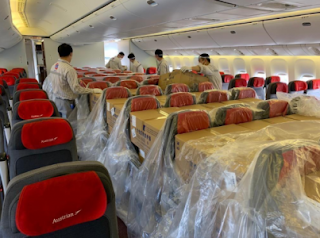An In-depth Analysis On The Use Of Passenger Aircraft For Cargo Operations.
Aviation Roundtable takes a closer look at the increasing use of passenger aircraft for cargo operation.With no passengers filling aircraft seats as demand is virtually non existent in the wake of Covid-19 pandemic, an increasing number of airlines are now piling cargo in the cabins of their aircraft in the hope to generate at least a fraction of the revenue they would have generated under normal circumstances.
Typically between 40% and 45% of air cargo is carried in the belly holds of passenger aircraft, while the rest is been ferried by conventional cargo freight operations. but most passenger flights are suspended as a result of travel restrictions and lower demand due to the Covid-19 pandemenic.
In contrast to the dramatic drop in passenger demand, air cargo operations are surging to respond to calls to move essential supplies to tackle the COVID-19 pandemic.
Amid the crisis, to supplement the continued cargo operations, airlines have been using their passenger aircraft fleets. This has been not only in the form of carrying sizeable cargo loads in the bellyhold on sparsely occupied passenger flights, but even dedicated cargo-only operations using these planes. Cargo is also loaded into the main cabin where it is distributed and balanced across the seats and secured with cargo netting.
In some instances, it has even involved the temporary conversion of the cabin by removing seats to create more useable space.
Many airlines have undertaken the use of their passenger aircraft for dedicated cargo missions spanning the globe, including Delta, Qatar Airways Cathay Pacific, Etihad, Emirates, Ethiopian, Airpeace, Austrian etc.These passenger aircraft are not only being operated by their respective airliners but are also being chartered by freight forwarders to boost their capacity. A positive side effect of these passenger-as-cargo operations is in keeping these aircraft flying, which minimizes the maintenance and operational effects of parked aircraft.
For a normal airworthiness approval to transport cargo in the cabin, a combination of various technical and operational measures was implement ed by IATA and also the aircraft manufacturers notably Boeing and Airbus. Some of which are highlighted thus;
*Passenger cabins do not have the fire suppression systems installed in cargo compartments, therefore cabin crews are required to be onboard, transitioning their role from flight attendant to in-flight firefighter.Cabin crew are also required to be on board these flights to manage any in-flight emergencies.
*Cabin cargo cannot include dangerous goods, which includes in-demand items like alcohol-based hand sanitizer and mercury thermometers.
*Cargo should not block emergency exits for smooth and expeditious evacuation in case of an emergency.
*Airlines carrying cargo in the cabin should have an observer onboard. This person should be supplementary to the flight crew, and IATA suggests flight attendants since they are already trained in emergency procedures, including in-flight fires. If airlines use other personnel, they should be briefed on all cabin aspects like cockpit communication.
*In-flight entertainment systems, in-seat power and galleys should be switched off so systems do not over-heat.
*With wide open space in the cabin for cargo, there is greater risk of items moving and overwhelming a structural limit or pressurization panel. The aircraft’s center of gravity (CG) as well as weight and balance must be re-calculated in line with the safety and smooth operation of the aircraft.
*Cargo should not exceed the height of seats and it should not block aisles. That allows cabin visibility to identify and reach any smoke or fire.
For longer and more extensive cargo operation, regulators, manufacturers and industry bodies are working to update and expand regulations and capacity. Consequently Lufthansa Technik was recently awarded a contract to support the conversion of an Airbus A380 from passenger to cargo configuration.
Passenger aircraft were initially needed for the urgent demand of large quantities of medical supplies. But as steady supply links are established and passenger flights show no sign of recovery, having cargo in the cabin is shifting from humanitarian needs to ordinary commercial opportunity. This is particularly important for export-heavy countries to minimize economic loss.
With the increasing use of passenger aircraft for cargo operations there are some concerns been raised in some quarters which need to be meticulously looked into at all times to ensure safety in this unprecedented period in the aviation industry. Some of the concerns include;
*While boxes of face masks in the cabin take up large volume with little weight, seafood and other general cargo can be dense, which passenger cabins are not designed for. Therefore careful planning and execution is critical and must be carried by all concerned. Before considering such operation, a comprehensive safety risk assessment shall be performed involving all the relevant operational departments (i.e.ground,cargo,cabin,flight,engineering).
*Cargo in the cabin raises old concerns. While passengers are fully identified and screened, cargo is not. There has been long-standing worry hazardous cargo is intentionally mis-labelled to avoid stricter carriage terms. Therefore, only 100% verified cargo be loaded in the cabin.
Simon Ogboji.
Picture credit: Austrian Airlines.





Comments
Post a Comment